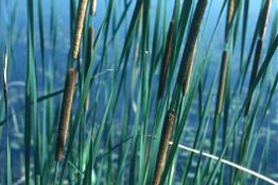Narrow-leaved cattail
(Typha angustifolia)
Perennial, erect wetland plant that is 5-10’ tall, often with a submersed base.
Other names for this plant include:
- Common names: narrow-leaf cattail, lesser bulrush
- Scientific names: T. angustifolia var calumetensis; T. angustifolia var elongata
Classification in Wisconsin: Restricted
- Ecological Threat
-
- Invades freshwater marshes, wet meadows, fens, roadsides, ditches, shallow ponds, stream and lakeshores.
- Plays an important role as a food source and shelter for some marsh-dwelling animals, but large mono-specific stands of invasive cattails exclude some less common species.
- Identification
-
Leaves: Erect, linear, and flat the leaf blades are 0.15-0.5” wide, and up to three feet long. About 15 leaves emerge per shoot. Dark green in color and rounded on the back of the blade. The top of the leaf sheath has thin, ear-shaped lobes at the junction with the blade that usually disintegrates in the summer.
Flowers: Numerous tiny flowers densely packed into a cylindrical spike at end of the stem, divided into the upper section of yellow, male flowers and lower brown, sausage-shaped section of female flowers. The gap between male and female sections is about 0.5-4” in narrow-leaved cattail. They flower in late spring.
Fruits & seeds: Seeds are tiny (about one mm), dispersed by the wind with the aid of numerous hairs. Each narrow-leaved cattail spike produces thousands of seeds that remain viable for up to 100 years.
Roots: Plants reproduce vegetatively by means of starchy underground rhizomes to form large colonies.
Similar species: Common (broad-leaved) cattail (Typha latifolia; native) generally does not have a gap between male and female sections of the inflorescence and differs in several often tiny features of the leaves, flowers, and fruits. Hybrid cattail (Typha x glauca) is a hybrid of common and narrow-leaved cattails, and its structure is intermediate between that of its parental species. The best way to identify the hybrids is to first learn the characteristics of T. angustifolia and T. latifolia, then look for plants that are intermediate.
- Control
-
Mechanical: Cut all stems, both green and dead in mid to late summer or early fall. Where possible maintain a water level of a minimum of 3” above the cut stems for the entire growing season.
Chemical: Foliar spray with aquatic approved imazapyr.
- Resources
- Sources for content:
- Czarapata, Elizabeth; Invasive Plants of the Upper Midwest: an illustrated guide to their identification and control. University of Wisconsin Press. 2005. Pg. 80-83
- Flora of North America. Typha angustifolia [exit DNR]. Vol. 22 Page 283, 284.



